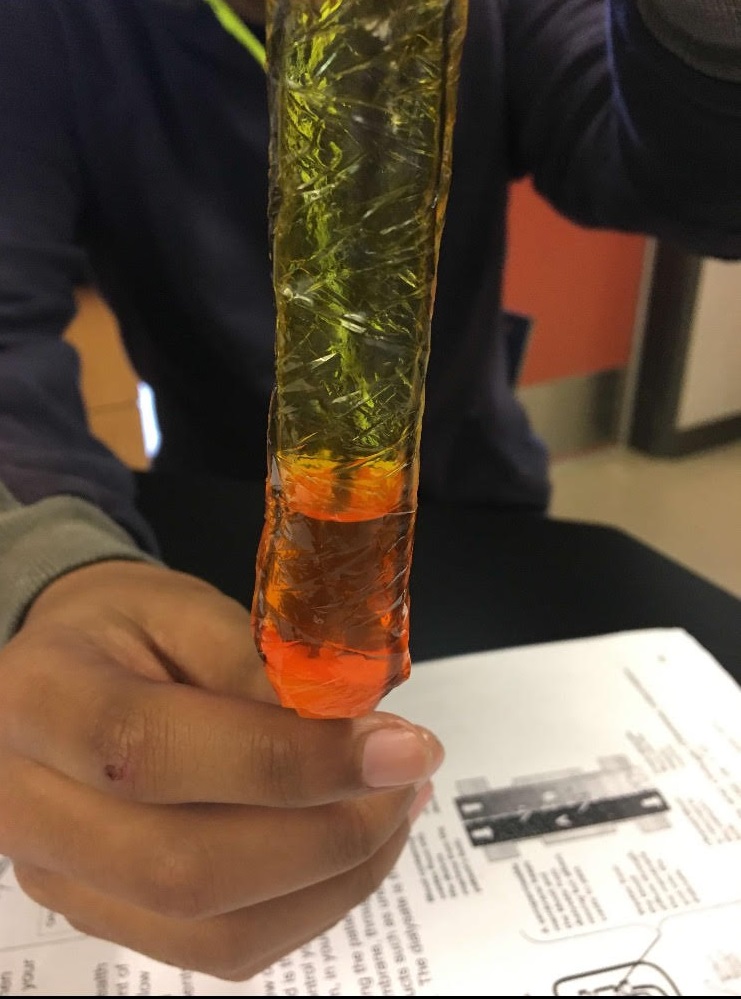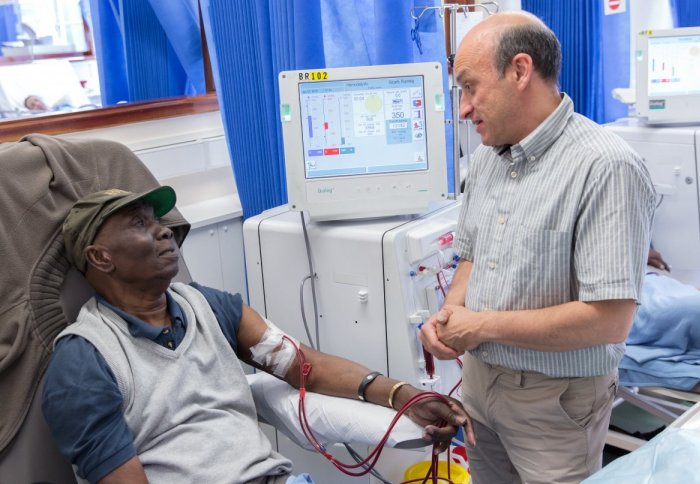
Dialysis tests & treatments nhs inform.

Dialysis Types Purpose Procedure Cost And Side Effects
Secure a small rubber band around the bottom of the dialysis tubing to seal it. wrap the rubber band around the dialysis tubing as many times as possible. test that the dialysis tubing will not leak out of the bottom by placing a few drops of water into the tubing. if water leaks out the bottom, the rubber band has not been fastened tight enough. To check if your dialysis is removing enough waste products, your doctor is likely to recommend tests, such as: peritoneal equilibration test (pet). this test compares samples of your blood and your dialysis solution during an exchange. the results indicate whether waste toxins pass quickly or slowly from your blood into the dialysate. In some cases, kidney failure may be a temporary problem and dialysis can be stopped when your kidneys recover. but often, someone with kidney failure will need a kidney transplant. it's not always possible to carry out a kidney transplant straight away, so dialysis may be needed until a suitable donor kidney becomes available. Blood tests. kidney function tests look for the level of waste products, such as creatinine and urea, in your blood. urine tests. analyzing a sample of your urine may reveal abnormalities that point to chronic kidney failure and help identify the cause of chronic kidney disease. imaging tests.
Haemodialysis. haemodialysis is the most common type of dialysis and the one most people are aware of. during the procedure, a tube is attached to a needle in your arm. blood passes along the tube and into an external machine that filters it, before it's passed back into the arm along another tube. Dialysis is a procedure that helps your blood get filtered by a machine that works like an artificial kidney.. based on the difference in techniques, there are two types of dialysis. hemodialysis: your entire blood is circulated outside your body in a machine placed outside the body known as a dialyzer. this dialyzer acts like an artificial kidney that cleans and returns the blood to your body. Test tubs aren't just for the lab! check out these surprising and practical text tube craft projects that will have you scattering the diminutive glass files all around the house. by jennifer noonan test tubes are commonplace and entirely u. Some kinds of acute kidney failure, also known as acute renal failure, get better after treatment. in some cases of acute kidney failure, dialysis may only be needed for a short time until the kidneys get better. in chronic or end stage kidney failure, your kidneys do not get better and you will need dialysis for the rest of your life.
The kidneys perform many functions to keep the body healthy. people with diabetes, high blood pressure, and a family history of kidney disease have a higher risk of developing a kidney condition. if the kidneys fail, an individual may requi. While there are several tests that monitor your kidney function and overall health, kt/v and urr are key ways to monitor the effectiveness of your dialysis treatment: kt/v should be at least 1. 2 or above—kt/v stands for clearance multiplied by time divided by volume. Old-style tv sets and other electrical products made between the 1930s and 1970s contain vacuum tubes for creating, amplifying and modifying electrical signals. the tubes function by controlling the electron movement in a low pressure envir.
Dialysis (hemodialysis): purpose, procedure, and complications.
What Specific Part Of The Kidney Does The Dialysis Tubing
Hemodialysis Access Options Fresenius Kidney Care
Hemodialysis Access Options Fresenius Kidney Care

Learn how to find the volume of liquid in a test tube and report the value using the correct number of significant figures. finding the volume of a test tube or nmr tube is a common chemistry calculation, both in the lab for practical reaso. Dialysis is the use of an "artificial kidney" an external machine that removes waste, Kidney Dialysis Tubing test chemicals and fluid from the blood. a urinalysis is another common test used to measure kidney function. A test tube holder is an apparatus designed to support and store test tubes during a scientific experiment. a test tube is a thin-glassed tube with one clo a test tube holder is an apparatus designed to support and store test tubes during a.
This test uses sound waves to get a picture of the kidney. it may be used to look for abnormalities in size or position of the kidneys or for obstructions such as stones or tumors. ct scan. Q i sent a patient with a glomerular filtration rate (gfr) of 15 ml/min to nephrology to start dialysis. he came back to me and said they don’t start dialysis a coronavirus news center clinician reviews in partnership with 1. cooper ba, bra.
More kidney dialysis tubing test images. Experiment 1: kidney filtration table 1: solutions present in each container before 60 minute submersion solution dialysis tubing beaker congo red yes no yellow food coloring yes no table 2: solutions present in each container after 60 minute submersion solution dialysis tubing beaker congo red yes no yellow food coloring no yes post-lab questions 1. what specific part of the kidney does the. Peritoneal dialysis is a treatment for kidney failure that uses the lining of your abdomen, or belly, to filter your blood inside your body. doctors call this lining the peritoneum. a doctor will place a soft tube, called a catheter, in your belly a few weeks before you start treatment.

Peritoneal dialysis is a treatment for kidney failure that uses the lining of your abdomen, or belly, to filter your blood Kidney Dialysis Tubing test inside your body. health care providers call this lining the peritoneum. use a transfer set to connect your catheter to the dialysis solution. a transfer set is tubing that you use to connect your catheter to the bag of. The top two indicators: kt/v and urr. while there are several tests that monitor your kidney function and overall health, kt/v and urr are key ways to monitor the effectiveness of your dialysis treatment: kt/v should be at least 1. 2 or above—kt/v stands for clearance multiplied by time divided by volume. Wrap the rubber band around the dialysis tubing as many times as possible. test that the dialysis tubing will not leak out of the bottom by placing a few drops of water into the tubing. if water leaks out the bottom the rubber band has not been fastened tight enough. if water does not leak pour the water out of the tubing into the sink.
injuring five others by injecting bleach into their kidney dialysis tubing was found guilty of capital murder friday ascend 2011 researchers have come up with two new tests that seem better able to predict which patients with chronic kidney disease are more likely to progress to kidney failure and death dialysis at home ? davita opens training facility in fort Test tubes are used by chemists in the lab to heat, hold and mix small quantities of liquid or solid chemicals during experiments. they have a round bottom test tubes are used by chemists in the lab to heat, hold and mix small quantities of. The hemodialysis catheter is connected to a central vein, and the other end of the hemodialysis catheter tubing exits your skin and attaches to the tubing on the dialysis machine. a hemodialysis catheter can be used immediately —you’ll be ready for hemodialysis right after placement.
/GettyImages-505354473-1e7e92ed07e7459daa992e52e4c1bff2.jpg)
Test date: during stages 3, 4 and 5 of kidney disease, when the renal diet is prescribed or if the person is on dialysis. know your labs your dietitian, doctor and other Kidney Dialysis Tubing test healthcare team members will monitor your test results and recommend dietary adjustments or make changes to your treatment. You typically start dialysis when you have symptoms or your lab tests show toxic levels of waste in your blood. symptoms of kidney failure include nausea fatigue swelling, and throwing up. Mainly used in laboratories and classrooms, test tubes are vessels that hold and mix or store materials for use in experiments and research. there are several different types of test tubes available, and they may be made from varying materi. Conduct microbiological testing specific to water in dialysis settings. ia, ic: c1: perform bacteriologic assays of water and dialysis fluids at least once a month and during outbreaks using standard quantitative methods. assay for heterotrophic, mesophilic bacteria (for example pseudomonas spp. ).